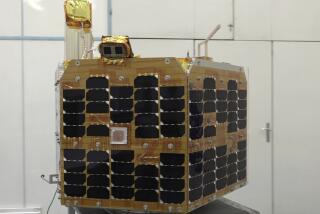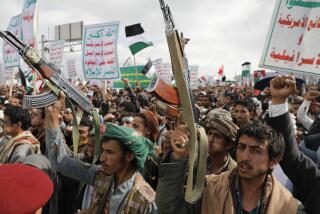Iran Put Missiles Near Gulf Entrance, U.S. Says
- Share via
WASHINGTON — Iran has deployed Hawk antiaircraft missiles on strategic islands around the Strait of Hormuz, the potential choke point for oil shipments through the Persian Gulf, President Clinton and Gen. John M. Shalikashvili, chairman of the Joint Chiefs of Staff, said Tuesday.
U.S. intelligence has also spotted Iran moving artillery into forward positions on the islands, Shalikashvili said. The Hawks, an older system originally sold to Tehran by the United States, could be used by Iran to help cut off traffic bound to or from the 550-mile waterway bordering eight Persian Gulf states.
“All of that can lead you to lots of conclusions. One of them is that they want to have the capability to interdict the shipping traffic in the Strait of Hormuz,” Shalikashvili said in a breakfast meeting with reporters. “What this is all about bothers us very much.”
At a news conference later, Clinton said that Iran’s military moves appear to pose “no undue cause for concern at this moment.”
“We’re monitoring them, trying to evaluate exactly everything we need to know about them, but we’re on top of the situation,” he said.
But U.S. officials said the moves underscore Iran’s “incremental” military buildup in recent months. The missile launchers were deployed late last fall at about the same time as the American buildup in the Persian Gulf, which took place in response to Iraq’s dispatch of troops toward the Kuwaiti border.
Neither Clinton nor Shalikashvili identified the specific islands, but U.S. officials told The Times that the missiles were deployed on Abu Musa and Tunb, two islands near the mouth of the strait.
U.S. analysts initially concluded that Iran did not intend to use the missiles to threaten civilian or military aircraft. “It appeared they were deployed mainly for defensive purposes,” one official said.
The Hawk missiles originally were not loaded onto launchers, but the systems were activated for the first time in recent days. “The other day they started putting missiles on their launchers, which they had not done before,” Shalikashvili said.
U.S. intelligence learned of the development through aerial reconnaissance, including spy satellites. The surveillance was monitoring neighboring Iraq for troop movements and violations of a U.N. ban on weapons of mass destruction.
Iran has long had in its arsenal Silkworm anti-ship missiles purchased from China. And Tehran more recently ordered diesel submarines from Russia. Both systems could be used in the Persian Gulf, military experts said.
Since the end of its costly eight-year war with Iraq, Iran has launched a major effort to rearm and rebuild its shattered military. Part of the program includes an allocation of hundreds of millions of dollars to buy arms from Russia.
“I think most of the military leaders in that part of the world and in Europe . . . are very worried about the trend that we are seeing in Iran,” Shalikashvili said.
Yet the Hawk deployment does not represent the kind of missile crisis caused by the former Soviet Union’s deployment of missiles in Cuba in the early 1960s. The United States probably will not have to react to developments so far.
More to Read
Sign up for Essential California
The most important California stories and recommendations in your inbox every morning.
You may occasionally receive promotional content from the Los Angeles Times.













